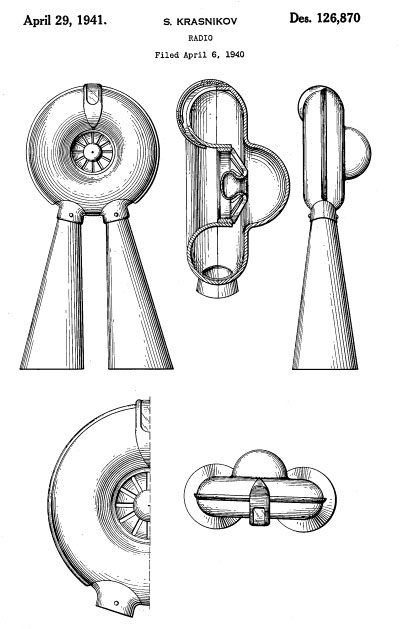|
Fantasy Radios-Design Patent Images 1930-1943 (Part 3) |
 |
|
Designers tried many approaches to integrating the radio function into everyday objects. In this case, a radio found its way into a pair of bookends. |
 |
|
This designer combined a clock and the radio dial into a single unit, a logical, but rarely used approach. Update: This radio does exist, and was sold under the "Meteor" name. |
 |
|
This one has a locomotive look to it, but if you look at some of the jukeboxes of the 1950's, you can see where this design may have led. |
 |
|
This radio was designed by Normal Bel Geddes for Majestic. |
 |
|
The dial and control configuration says this is one of Zenith's infamous Bakelite chassis radios, but this one never made it into production. |
 |
|
The 1939-40 New York World's Fair's "Trylon and Perisphere" logo inspired this designer to create this design for a combined radio and clock. It looks like the Trylon was optional, so it could have been sold as a non-World's Fair item, without having to pay a licensing fee to the fair corporation. But, no matter, it was never produced in any form. |
 |
|
The brief demand for beer keg radios that came with the repeal of Prohibition had surely run its course by 1940, but this designer tried unsuccessfully to revive it in this barrel-shaped console radio. |
|
|
|
Was this meant to resemble the beacon in a light house? A siren? A motor housing? I really have no idea, but it's an interesting design none the less. |
 |
|
This weird radio looks like the impeller side of the turbochargers that were commonly used on aircraft engines in the 30's and 40's. The "feet" would have been air pipes leading to the intake manifolds. |
 |
|
Here's another aircraft-inspired radio design, in this case, the entire airframe is replicated. It appears that the propeller tunes the radio, and the propeller hub is the volume control. |
 |
|
This rather interesting design emerged just before the US entered WW-II. In this case, it is just an engine nacelle. As in the previous design, the propeller and hub are the radio controls. |
 |
|
Zenith produced some strange designs in the late 30's and early 40's. They apparently considered some that were truly bizarre, like this clock radio. It's not even clear what it was supposed to look like. |
| Back to Page 2 |
| Home |